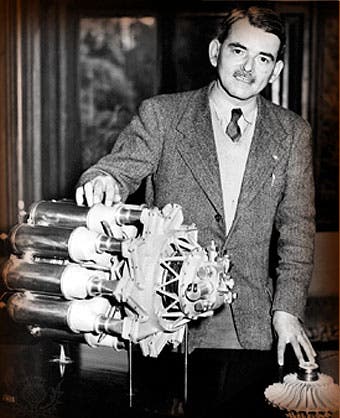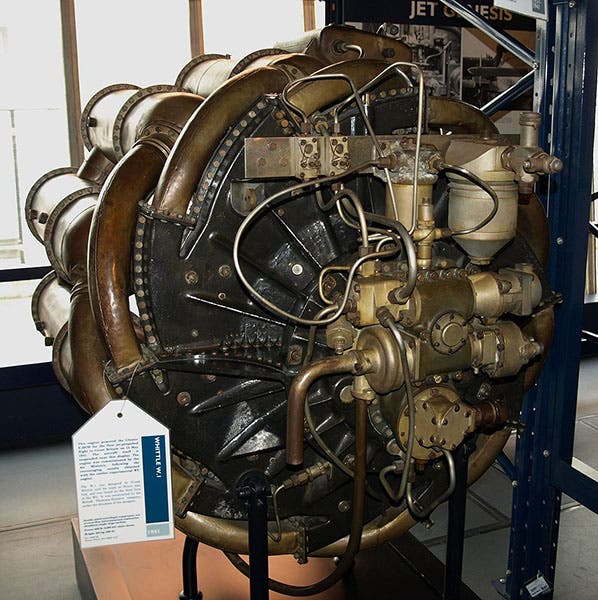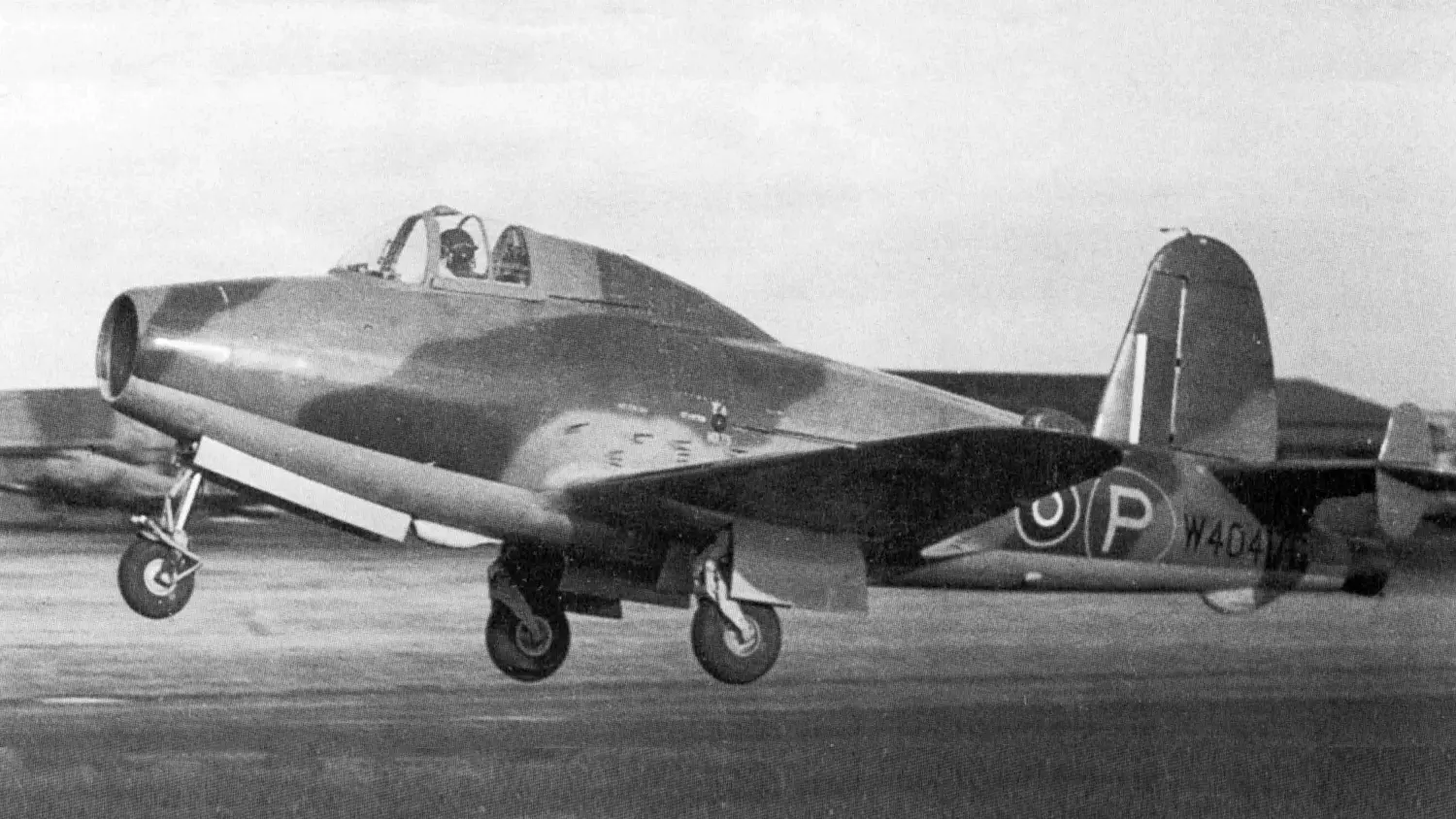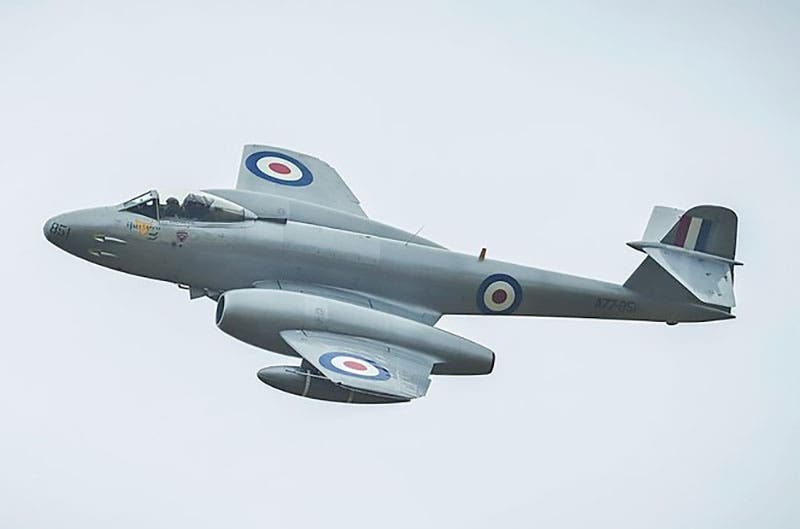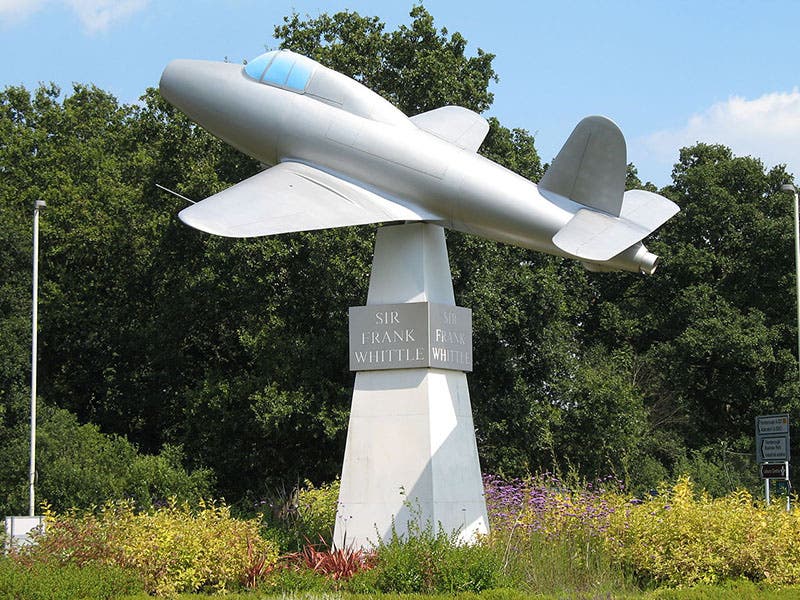Scientist of the Day - Frank Whittle
Frank Whittle, an English mechanical engineer and Royal Air Force pilot, was born June 1, 1907. Whittle was one of two people who invented, built, and successfully deployed the first turbojet engines for aircraft. The basic idea of the turbojet is that you compress air, inject fuel into the compressed air and ignite it, and then use the exhaust gases to turn a turbine, which drives the compressor up front. Whittle had that basic idea by 1930, when he secured his first patent. But for 7 years he was unable to interest anyone in the Air Ministry in developing a turbojet engine. Eventually, in 1936, he formed his own company, Power Jets Limited, and secured minimal funding from private sources to carry on.
The thing about a turbojet engine is that it is simple in principle but extremely tricky to design and build. Each of the blades in the compressor and the turbine is a miniature airfoil and has to be precisely shaped. Those in the turbine must be able to withstand the red-hot exhaust temperatures. And the rotor has to turn at about 17,000 rpm, four times faster than a piston engine, which is hard on bearings and structural integrity, since things to tend to want to fly apart at those speeds.
Despite the engineering obstacles, and the fact that he had no official support, Whittle and Power Jets were able to bench test an operating turbojet, built to Whittle's designs, on Apr. 12, 1937 (third image). Although the tests were quite harrowing until they tracked down the sources of leaking fuel, they were successful, and his engine produced the power that Whittle had predicted. The Royal Aircraft Establishment (RAE) suddenly thought that the turbojet engine was not such a bad idea, and official support and funding now became available, although the bureaucratic hoops Whittle had to jump through for the four years of development, detailed in his autobiography (Jet: The Story of a Pioneer, 1954), are appalling. The Wright Brothers had it easy, compared to Whittle, with no one to answer to except themselves.
The next step for Whittle was to design a jet engine that would fit in an airplane fuselage, and then get that aircraft into the air. The Gloster Company, working closely with Whittle, designed a small plane around Whittle's engine, which was called the W.1 (for Whittle 1). This was a fat engine, as jet engines go, because Whittle used what is called a centrifugal compressor, so that the compressed air emerged from the compressor along the outside, and the fuel chambers were thus also on the outside. There is an experimental version of the W.1, called the W.1.X, in the National Air and Space Museum in Washington (first image), so you can see what the first turbojet engine looked like. It is a fairly impressive piece of machinery, for an initial model. The plane in which the W.1 was installed in 1941 was called the Gloster E.28/29, and it was a handsome little craft (fifth image). It made several test taxis in early May of 1941 (including some hops that might qualify as flights in some quarters), and then on May 15, 1941, the E.28/29 took off and flew for 45 minutes, and flew perfectly. The pilot, who of course had never flown a jet-powered aircraft before, was instantly at home, and the whole affair was a smashing success. The Air Ministry had declined an invitation to film the inaugural flight, and so we have no video of the epochal event, but there are a few still photographs, of which we show one here (fifth image).
The RAE immediately commissioned a production jet aircraft, called the Gloster Meteor, and Whittle developed improved turbojets to power it (sixth image). The prototype first flew on Mar. 5, 1943. Production models came off the line in 1944, but only a few were able to join the war effort. But the United States Defense Dept. begged for specifications so they could begin building their own jet aircraft, and Power Jets sent them the model W.1.X – the very one shown in our first image – and from it, General Electric was able to build their own turbojet engines, which were fully functional by 1942. In that year, an American aviator, Najeeb Halaby, set a jet altitude record of 46,000 feet in a Bell P-59 (the first U.S. prototype jet aircraft), about 26,000 feet higher than you could ever take a piston-driven airplane, and in 1945, Halaby made the first coast to coast flight in a jet aircraft, in a Lockheed P-80, the first U.S. production jet aircraft.
Although it took a long time for Whittle to get noticed, he received plenty of attention after the war, and indeed for the rest of his life, which ended in 1996. There are many monuments to Whittle scattered around; we show just one, a crude model of a Gloster E.28/29, with Whittle’s name attached, that sits in a roundabout near Farnborough, Hampshire, where the RAE was headquartered during the War. It turns out that the turbojet engine was independently invented in Germany by Hans von Ohain, and the Germans flew a jet aircraft in 1939, two years before that happened in England. But the Ohain engine was never really successful, and the design was abandoned, while Whittle's just kept getting better and better and was the basis for all turbojet engines produced and flown in Britain and the United States for decades.
In researching this post, I ran across a reference to an article by Whittle included in a book called The Jet Age: Forty Years of Jet Aviation (1979). We have this book in our library, and in looking up Whittle’s paper, I discovered that it was originally delivered as part of a symposium held at the National Air and Space Museum on Oct. 26, 1979. The participant list was awesome. Besides Whittle, the speaker list included Ohain, Halaby, two other pioneering jet-engine designers, and Chuck Yeager, of Right Stuff fame, everyone’s favorite test pilot. I wish I had known about the event and had attended. That would have been a memorable day for fans of aviation history.
William B. Ashworth, Jr., Consultant for the History of Science, Linda Hall Library and Associate Professor emeritus, Department of History, University of Missouri-Kansas City. Comments or corrections are welcome; please direct to ashworthw@umkc.edu.



